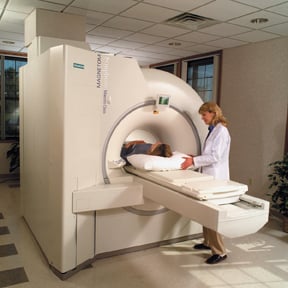
CDI centers use a variety of MRI systems, including Siemens Espree 1.5T.
Outcomes for the outpatient imaging industry are uncertain. The current state of the economy and the effects of the Deficit Reduction Act of 2005 (DRA), which has significantly cut Medicare reimbursement for imaging centers, are leaving outpatient-imaging centers few choices. Either they cut back and become lean, or close their doors. Some of the lucky ones will be absorbed by a nearby hospital, seeking to reclaim outpatient business that trickled to smaller centers.
As consolidation reshapes the outpatient imaging market, so too must the imaging centers restructure their strategies and their delivery of care.
Surviving Consolidation
Just last April, the Center for Diagnostic Imaging (CDI), a large imaging services group, and Radiology Consultants of Washington (RCW) announced a definitive merger agreement to combine their eight Washington outpatient imaging centers. The hope is that the strengths of both organizations will further enhance their joint mission of bringing high-quality and convenient medical imaging care to physicians and patients.
Headquartered in Minneapolis, CDI has been providing outpatient radiology imaging services since 1981, and currently owns and operates 51 diagnostic imaging centers in nine states. In a roundtable discussion at the Center for Diagnostic Imaging (CDI), Imaging Technology News (ITN) spoke with Robert Baumgartner (CEO), Tom Tomlinson (COO) and Steve Fischer (CIO) about consolidation amongst imaging centers.
ITN: How has reduced reimbursement for imaging exams caused by the DRA affected profitability for imaging centers?
Baumgartner: The effects of the 2005 DRA, which went into effect on January 1, 2007, have now been fully realized and, as a result, we are seeing many imaging providers on the verge of failure and closures in several of our markets. We are also hearing of providers who have curtailed the maintenance and upgrading of their imaging equipment, causing more substandard images and potential safety risks, especially with CT services. Because of the margin compression caused by DRA, there are more imaging centers for sale at liquidation-level pricing, which has in turn pulled down the market multiples being offered. More importantly however is the impact caused by the credit crunch, which has made it very difficult to source capital to acquire centers. Even the larger imaging players and investment funds cannot use as much leverage in their acquisition strategy, which means prices need to come down for any transactions to take place.
ITN: Do you foresee a resurging trend among hospitals and health systems to buy imaging centers? If so, how will it affect the imaging center market?
Baumgartner: Again, healthcare is local, so you will see a good deal of variation between markets. Certainly hospitals see the benefit of outreach into the local community. Many hospitals have been active in acquiring primary care groups and, in certain instances, imaging centers, and see this as a way to capture market share and eliminate a competitor. Since hospitals are reimbursed upwards of two times what a freestanding outpatient-imaging center is, the payback can be quick for these types of acquisitions. However this trend may slow with the credit crunch as most hospitals have very limited capital right now and are also feeling the effects of a slow economy. A recent report said 50 percent of all hospitals are losing money.
ITN: Do you anticipate radiology groups will continue to merge or will there be reverse mergers amongst radiology groups that couldn’t make their mergers work?
Baumgartner: Though we have not seen mergers in the markets CDI serves, we do see some of the weaker radiology groups disbanding or being absorbed by larger groups. As it relates to outpatient imaging, we believe we will see one or two strong radiology groups survive in most markets and that the hospitals will be strong competitors in the future as they acquire more referral sources. It will be difficult for the small free-standing imaging center to survive in many markets.
ITN: How can these centers leverage their existing operational infrastructure to improve profitability?
Tomlinson: The cost side of diagnostic imaging is driven by two primary levers: capacity and utilization. Affecting change in each of these levers boils down to developing and executing on key processes within the clinic, with visibility to performance provided by the right metrics. For example, at CDI, a key driver of utilization is what we call schedule completion: ensuring that every order we receive, whether via fax, Web site, phone call, or e-mail, results in a successfully completed test for a patient. In order to drive performance on schedule completion, we focus on metrics such as orders to be scheduled, cancellations and reschedule rate, aborted exams, etc. Each of these key metrics has a process behind it that we are constantly striving to improve, in part by looking to best practices across all CDI centers as well as benchmarking with other providers.
ITN: What kind of strategic partnerships can help these centers to expand the patient population they service?
Baumgartner: Each market is unique so it’s difficult to pinpoint any one strategy, though there are definite opportunities to expand or combine product offerings within our communities. We believe that collaborations with hospitals, partnering with radiologists on new clinical product offerings, and innovating services that make us more transparent and easier-to-use for our patients will be key.
ITN: What kind of strategic investments in imaging technology could help expand market share and services?
Fischer: Imaging technology is critical to our overall strategy, particularly as it relates to connecting us electronically and seamlessly to physicians and patients. This includes direct system/EMR integrations; Web-based portals for accessing patient records and results anytime/anywhere; online ordering; and involvement and integration with personal health records.
For more information on the Center for Diagnostic Imaging (CDI), please contact Bob Baumgartner, CEO, Tel: 952.525.6310 or go to www.CDIradiology.com


 December 15, 2025
December 15, 2025 









